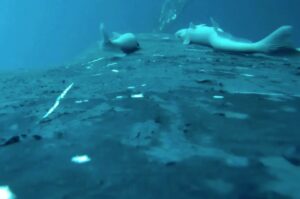From 1888 to 1912, boats traversing a narrow channel of water in New Zealand’s Cook Strait had an unusual escort. A lone Risso’s dolphin regularly guided ships through treacherous waters near French Pass. It became such a welcome guardian that some ships even waited for the dolphin to appear before proceeding with their journey.
Risso’s dolphins
Risso’s dolphins, also called grey dolphins, live in tropical and temperate waters — the Pacific, Atlantic, Indian, and Mediterranean. Their personality varies. Most are shy but a few seem to be more outgoing. They like to stay near the surface of the water, breaching, flapping their flippers and tails, and sticking their round heads into the open air. While they prefer hanging out in pods of up to 30, they venture off on their own from time to time.

A Risso’s dolphin in the water in California. Photo: Michael L. Baird/Wikipedia Commons
Risso’s dolphins are stocky and often have deep scars on their white, grey or brown skin from fights with other dolphins. Ranging from 300 to 500kg, they measure up to three meters long and live up to 35 years.
Pelorus Jack appears
Witnesses first spotted Pelorus Jack in 1888. Traveling near French Pass between D’Urville Island and South Island, passengers on the schooner Brindle noticed a white Risso’s dolphin, about four meters long, in the water at the front of the ship. It hung with the schooner for around 24 hours, seemingly leading it to safer waters.
Similar incidents occurred over the years. People named the dolphin Pelorus Jack, after Pelorus Sound, the spot where the dolphin began to accompany a ship. It tended to stay close to a vessel for about 20 minutes. Remarkably, its guidance prevented any shipwrecks or accidents from rocks and dangerous currents in that treacherous region. This prompted some ships to wait for the dolphin to appear before proceeding through that ticklish section.
No one ever confirmed if Pelorus Jack was male or female, but photographic analysis suggests it was male. Males tend to be bigger than emales.
Behavior
According to newspaper accounts in the early 1900s, Pelorus Jack had a flamboyant personality.
“He dived under our keel, then shot ahead again, and turning a complete somersault treated us to what I can only describe as a display of marine hurdle racing,” said one account.
Another mentioned Pelorus Jack’s “impatience by occasionally leaping out of the water.”
These highlight not only the dolphin’s character and intelligence but also the local people’s attachment to it. They humanized it, and it eventually became a valuable member of the shipping community.

Pelorus Jack. Photo: Capt. C. F. Post, of the N.Z. Govt. SS Tutanekai
One might ask why a dolphin would exhibit such behavior. While there is no official explanation, some speculate that it might have been bored or liked riding the bow waves of the ships, as dolphins do.
However, what most surprised witnesses was Pelorus Jack’s behavior after it was almost killed by a crewman of SS Penguin in the early 1900s. For whatever reason, the crewman tried to harpoon it, but it survived. While this did not deter Pelorus Jack from accompanying ships, it steered clear of the SS Penguin when it returned to the area. Its avoidance of that ship led to its shipwreck in those waters.
Protected animal
After the incident with the crewman on the SS Penguin, outraged locals demanded that Pelorus Jack receive protected status. The governor himself signed an official decree that hunting in those waters was punishable by a fine of up to £100. New Zealand thus became the first country to legislate protection to a marine mammal.
Disappearance
After a long career of helping ships, Pelorus Jack eventually disappeared in 1912. Most likely, the beloved dolphin died of old age. Rumor had it that the crew of a whaling vessel found a dolphin’s body washed up on shore in the area. But this remains unconfirmed.
Yet Pelorus Jack’s legacy lived on. The inter-island ferry service from Wellington to Picton uses the dolphin as its official logo.






